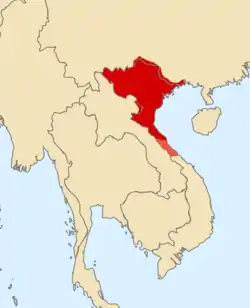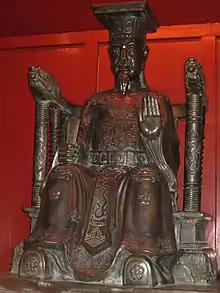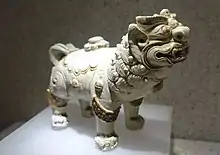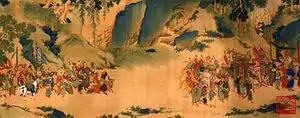Lý dynasty
The Lý dynasty (Vietnamese: Nhà Lý, Vietnamese pronunciation: [ɲâː lǐ], chữ Nôm: 茹李, chữ Hán: 李朝, Hán Việt: Lý triều), also known as the House of Lý, was a Vietnamese royal family that ruled the kingdom of Đại Việt from 1009 when Lý Công Uẩn overthrew the Early Lê dynasty and ended in 1225, when the queen Lý Chiêu Hoàng (then 8 years old) was forced to abdicate the throne in favor of her husband, Trần Cảnh. During emperor Lý Thánh Tông's reign, the official name of Vietnam became Đại Việt.
Đại Cồ Việt (1009–1054) Đại Việt (1054–1226) Đại Cồ Việt Quốc (大瞿越國) Đại Việt Quốc (大越國) | |||||||||
|---|---|---|---|---|---|---|---|---|---|
| 1009–1225 | |||||||||
 Territories of the Lý dynasty | |||||||||
 Map of Vietnam during Lý dynasty, c. 1085 | |||||||||
| Status | Internal imperial system within Song tributary[1][2] | ||||||||
| Capital | Hoa Lư (1009–1010) Thăng Long (1010–1225) | ||||||||
| Common languages | Medieval Vietnamese, Chinese[3] | ||||||||
| Religion | Buddhism | ||||||||
| Government | Monarchy | ||||||||
| Emperor | |||||||||
• 1009–1028 | Lý Thái Tổ (first) | ||||||||
• 1054–1072 | Lý Thánh Tông | ||||||||
• 1072–1128 | Lý Nhân Tông | ||||||||
• 1224–1225 | Lý Chiêu Hoàng (last) | ||||||||
| Chancellor | |||||||||
• 1058 | Lý Thường Kiệt | ||||||||
• 1069–1073 | Lý Đạo Thành | ||||||||
• 1140–1158 | Đỗ Anh Vũ | ||||||||
• 1158–1179 | Tô Hiến Thành | ||||||||
• 1208–1211 | Tô Trung Từ | ||||||||
• 1225 | Trần Thủ Độ (last) | ||||||||
| Historical era | Medieval Asia | ||||||||
• Coronation of Lý Công Uẩn | 21 November 1009 | ||||||||
• War with Dali kingdom | 1014 | ||||||||
• Lý Thánh Tông change national name from Đại Cồ Việt to Đại Việt | 1054 | ||||||||
| 1075–1077 | |||||||||
| 1225 | |||||||||
| Currency | xu, văn | ||||||||
| |||||||||
| Today part of | Vietnam China Laos | ||||||||
| Lý | |
|---|---|
| Country | Kingdom of Đại Việt (Vietnam) |
| Founded | 1009 |
| Founder | Lý Công Uẩn |
| Final ruler | Lý Chiêu Hoàng |
| Titles |
|
| Estate(s) | Thăng Long |
| Deposition | 1226 |
Part of a series on the |
|---|
| History of Vietnam |
 |
| Timeline |
|
|
Domestically, while the Lý monarchs were devout to Buddhism, the influence of Confucianism from China was on the rise, with the opening of the first University in Vietnam in 1070 for selection of civil servants who are not from noble families.The first imperial examination was held in 1075 and Lê Văn Thịnh became the first Trạng Nguyên (Zhuangyuan) of Vietnam. Politically, they established an administration system based on the rule of law rather than on autocratic principles. The fact that they chose the Đại La Citadel as the capital (later renamed Thăng Long and subsequently Hanoi) showed that they held onto power due to economic strength and were liked by their subjects rather than by military means like previous dynasties. Noblemen scholars such as Lê Văn Thịnh, Bùi Quốc Khái, Doãn Tử Tư, Đoàn Văn Khâm, Lý Đạo Thành, and Tô Hiến Thành made vast contributions culturally and politically, allowing the dynasty to flourish for 216 years.
History
Background
In 1009, the Early Lê dynasty passed from flourish and downfall in 29 years with 3 Emperors Lê Đại Hành, Lê Trung Tông and Lê Ngọa Triều. The last emperor Lê Ngọa Triều died in 1009 after evil and brutal ruling in Đại Cồ Việt which made him and his dynasty becoming unpopular to civilians. According to some history records of Vietnam like Khâm định Việt sử Thông giám cương mục, Việt sử lược, Đại Việt sử ký toàn thư all proved that in October 1009, Lê Long Đĩnh died because of consequence of his licentious life . The crown prince of Lê Long Đĩnh was still very young and he could not take the power from his dad. Then, the conference by the members of royal court was held to discuss about the fate of nation. Finally, Lý Công Uẩn,the high position mandarin and aristocrat was chosen by Đào Cam Mộc and Vạn Hạnh buddhist monk to become the new emperor of Đại Cồ Việt.
Founding

The founder of the Lý dynasty, Lý Công Uẩn (李公蘊) had origins from Fujian province somewhere in his paternal bloodline,[4][5][6][7][8] while little is known about his maternal side except for the fact that his mother was a woman named Phạm Thị. Very few direct details about his parents are known,[9] however, the ethnic Chinese background of Lý Công Uẩn, at least on his paternal side, was accepted by Vietnamese historian Trần Quốc Vượng.[10]
The Lý dynasty was started by Lý Công Uẩn, a former temple orphan who had risen to commander of the palace guard, succeeded Lê Long Đĩnh of the Early Lê dynasty in 1009, thereby founding the Lý dynasty. He took the reign name Lý Thái Tổ. The early Lý emperors established a prosperous state with a stable monarchy at the head of a centralized administration. The name of the country was changed to Đại Việt in 1054 by Emperor Lý Thánh Tông.
Moving the capital
After a year of enthronement, in 1010, Lý Thái Tổ started to move the capital from Hoa Lư(Ninh Bình) to Đại La(Hà Nội), and renamed it Thang Long. He wrote the Edict on the Transfer of the Capital to announce his plan to move to the new place.

This decision had a marked influence on Vietnam, which opening the flourishing era of the dynasty Following dynasties such as Trần, Lê and Mạc continued to use Thang Long as their capital, as does the Socialist Republic of Viet Nam today.
Throne crisis
In 1028, Lý Thái Tổ died at the age 55 with Posthumous name Thần Vũ hoàng đế (神武皇帝), buried at Thọ royal tomb. In his funeral, Most of his mandarins expected crown prince Lý Phật Mã to take a throne however 3 of his brothers are Duke of Đông Chinh(Đông Chinh vương),Duke of Dực Thánh(Dực Thánh vương) and Duke of Vũ Đức(Vũ Đức vương) rejected this decision, then ambushed royal palace by their own armies to steal the throne. Crown prince Lý Phật Mã discovered the danger, then ordered to close all the gates of palace and arranged guards for protection. However his eunuch Lý Nhân Nghĩa advised him to fight with betrayer. Thus, Lý Phật Mã decide to let Lý Nhân Nghĩa to lead the royal army to fight against his brothers.Lý Nhân Nghĩa succeeded in his campaign and caught Vũ Đức Vương, the 2 others escaped. After that,Lý Phật Mã enthroned and take the temple name Lý Thái Tông. To grant his mercy to all those who tried to opposed him, he pardoned his two brothers Đông Chinh vương and Dực Thánh vương.
Golden era

From the reign of Lý Thái Tổ with the other emperors, Lý dynasty began to focus on solving some major and minor situation:
- Strengthen internal rule: the economy was promoted to high progress, especially agriculture. The government introduced "Hình thư" (Ministry of Punishments) as the first system of law and legislation of Vietnam after gain independence from China and opened the education system based on imperial examination of China
- Strengthen territory reigning : The royal court tried to expanded their influence to the remote areas by managing the marriage policy such as giving princesses to marry with the other local lords for closer relationships with royal family. To conciliate those who were not loyal mto government, the emperor will order princes to eliminate the revolts.
- Protecting country from foreigners: Resolve and reconcile some minor issues with Song dynasty, fighting against the invasion of Nanzhao and Champa.

One of the big event of Lý dynasty is changing name of country from Đại Cồ Việt (大瞿越) to Đại Việt (大越) in 1054 under reign of Lý Thánh Tông.

During the Lý dynasty, the Vietnamese began their long march to the south (Nam tiến) at the expense of the Chams. In 1069, Champa Kingdom gained more support from Song dynasty so Cham stopped paying tributary to Đại Việt so this made the Vietnamese government felt angry. As the result, the emperor Lý Thánh Tông made the expedition against Champa – (Champa-Đại Việt war 1069) and successfully captured the king of Champa Rudravarman III. Then Rudravarman III have to sign a treaty with Lý Thánh Tông to cede the Quảng Nam, Quảng Trị and Quảng Bình to Đại Việt which massively contributed to the expansion of Đại Việt territory. Consequently, Champa had to restore the tributary system to Lý dynasty . Soon afterwards, Vietnamese peasants began moving into the untilled former Cham lands, turning them into rice fields and moving relentlessly southward, delta by delta, along the narrow coastal plain. The Lý Emperors supported the improvement of Vietnam's agricultural system by constructing and repairing dikes and canals and by allowing soldiers to return to their villages to work for six months of each year. As their territory and population expanded, the Lý Emperors looked to China as a model for organizing a strong, centrally administered state. In 1070 Lý Thánh Tông ordered to construct Royal academy school to educate people. Minor officials were chosen by examination for the first time in 1075, and a civil service training institute and an imperial academy were set up in 1076. In 1089 a fixed hierarchy of state officials was established, with nine degrees of civil and military scholar officials. Examinations for public office were made compulsory, and literary competitions were held to determine the grades of officials.[11]
Depression era
Emperor Lý Nhân Tông was the longest reign ruler in the history of Vietnam. However he was childless so he had to choose some of kids of royal relatives as the successor and then Lý Dương Hoán (李陽煥), his nephew was chosen to be the crown prince. In 1128, Lý Nhân Tông died at aged 63. At that time, Lý Dương Hoán enthrone at 11 year olds and took temple name Lý Thần Tông. The incident of death of Lý Nhân Tông had marked the transition of crown succession from main line to cadet line and also ended the flourish era of Lý dynasty. After the reign of Lý Nhân Tông, all of his successors were too young and under control by regent and this led to the power competition among the regent. In the early of Lý Thần Tông era, Most of the member of government were good people who supported emperor to rule the stable Đại Việt. Those people include Chancellor Lê Bá Ngọc(黎伯玉), Vice chancellor Dương Anh Nhĩ (杨英耳), Lý Công Bình, Mâu Du Đô (缪攸度) and Lý Sơn (李山)... In Lý dynasty, Most of emperors had a favourite hobby of collecting the rare and precious treasures and this hobby become emerging when emperor Lý Thần Tông grew up. Then this causes the increase existing of corruption, people who flattered or gave the emperor the precious good, can get into the high rank position in the court. In 1138, Lý Thần Tông died at 23 year old after ruling in 10, years. before his death, Lý Thiên Lộc (李天禄), the first son and had been granted title dauphin of Đại Việt. Nevertheless, 3 Concubines Cảm Thánh, Phụng Thánh and Nhật Phụng corrupted the eunuch Từ Văn Thông (徐文通) to encourage emperor to change his mind. The emperor was persuaded and replaced prince Lý Thiên Tộ (emperor Lý Anh Tông) as crown prince when he was 3 year old.
Regent
.jpg.webp)
After that, Concubine Cảm Thánh became the empress dowager and she fell in love with Đỗ Anh Vũ (杜英武) who was sibling of empress Đỗ. She had the high confidence on lover so she put him as the regent of emperor Lý Anh Tông. This situation cause some opposition of mandarin and royal members, then followed by the coup of capturing Đỗ Anh Vũ . He was not killed but must live exile as the farmer who works for the state. The empress dowager tried to restore the position for Anh Vũ and she succeeded to bring him back as the regent and the chancellor. Đỗ Anh Vũ wanted to revenge who took him down by controlling the young child emperor to pass the law against the people who got involved in the coup. The emperor unwillingly had to approve it and all people who were impeached, then executed or go exile. In 1158, Đỗ Anh Vũ died and Tô Hiến Thành (蘇憲誠) who was the relatives of wife of Anh Vũ, later become the chancellor. Different from his brother in law, Tô Hiến Thành was the loyal subject to the Lý dynasty with skills and talents in organising military. He helped army to invade Champa and Lan Xang In 1174, dauphin Lý Long Xưởng caused debauchery with concubine of emperor, so he was deposed and emperor Lý Anh Tông made Lý Long Cán as dauphin. Tô Hiến Thành still hold the regent and vice chancellor because he was too young. In 1175, emperor Anh Tông died at aged 40, reigned in 36 years. The young dauphin had to enthrone with title emperor Lý Cao Tông and Lý dynasty began deep in the decline.
Decline
Lý Cao Tông became the emperor at 3 and his mom concubine Đỗ became Chiêu Thiên Chí Lý empress dowager, Her younger brother Đỗ An Di became Consort kin and Tô Hiến Thành was still a regent and teacher to teach the emperor.[12] However, Chiêu Linh empress dowager, mom of depose dauphin Lý Long Xưởng who tried to take the throne back for his son but not successful because of Tô Hiến Thành's determination In middle of 1179, Chancellor Tô Hiến Thành died when emperor Cao Tông was only 6 and Đỗ An Di replace him as regent. In 1188, Đỗ An Di died and Ngô Lý Tín replace his mission til death in 1190. Then, Đàm Dĩ Mông (譚以蒙), younger brother of Empress An Toàn, became regent. Emperor Lý Cao Tông was raised up in the luxury life and he allowed to make court position sale which led nation into crisis. The useless or rich people could be promote as the high rank officials so this increased the social unrest, corruption, poverty and thief . Finally, these cause a lot of revolts against royal court by local leaders.
Quách Bốc rebellion
The emperor Lý Cao Tông enjoyed the luxury life and exploit the property of civilians to build the palace and castle and the hatred of people was being cumulated and some revolts happened, typically Quách Bốc rebellion (chữ Hán: 郭卜之亂, Quách Bốc chi loạn) that was the main reason of weakening the dynasty and the power was seized by the other houses. The Governor Đoàn Thượng (段尚) of Hồng province (now Hải Dương and Hải Phòng provinces) began the revolt against the court. The emperor ordered generals Phạm Bỉnh Di (范秉異), Phạm Du (范兪), Đàm Dĩ Mông and the others to lead army to suppress the revolt. Nevertheless, Đoàn Thượng corrupted Phạm Du to retreat his infantry and persuade emperor to retreat all soldiers successfully. Đoàn Thượng got the victory Phạm Du then was nominated to train the military in Nghệ An but he started to recruit the thief and criminals to make the robbery everywhere. Cao Tông dispatched Phạm Bỉnh Di to catch Phạm Du, the Du lost the battle and fled to Hồng province. In 1209, the emperor summoned Du back to Thăng Long but Du slandered Phạm Bỉnh and prove him innocent. However, Cao Tông trusted Du's accusation and ordered to capture Phạm Bỉnh Di and his son (Phạm Phụ). After getting news of capture his lord, the general of Bỉnh Di was Quách Bốc (郭卜) who decided to fight into the royal palace to rescue his master. Emperor Cao Tông and Phạm Du suddenly killed Bỉnh Di and son and both fled to (Vĩnh Phú, Yên Bái). Quách Bốc captured the royal palace and celebrate the funeral for his master, then made son of emperor Cao Tông (Lý Thầm) to be the new emperor. Prince Lý Hạo Sảm (李日旵) fled to Hải Ấp with his mother Empress An Toàn, they met the leader of Trần clan, Trần Lý (陳李) and scholar Phạm Ngu both support Lý Hạo Sảm as the emperor. Lý Hạo Sảm then married to the daughter of Trần Lý, Trần Thị Dung (陳氏庸), after that he nominated and grant promotion to the people of Trần clan The emperor Lý Cao Tông thought prince Sảm wanted ti be the emperor and against him. Therefore; then he fought against Sảm but failing to reclaim the throne .After that, Trần Lý led the army against Quách Bốc at capital city and won .The rebellion was ended
Rise of Trần clan
In winter 1216, Concubine Thuận Trinh was granted the title as "Empress". People of Trần clan were nominated in some important position in the court: Tự Khánh was chancellor, His brother Trần Thừa as interior guard with title Marquis, Phùng Tá Chu and the first son of Trần Thừa (Trần Liễu) as interior mandarin and the first son of chancellor Trần Hải as Duke of Hiển Đạo "Hiển Đạo vương (顯道王)". In 1217, Đoàn Thượng surrendered to the court, pardoned and granted title of Hồng vương, ruler of Hồng province. At this time, emperor Lý Huệ Tông usually turn into like crazy man and calling himself as Heaven General (Thiên tướng) and helike to put the flag on chignon, holding sword and shield for dancing. Then, he drank and slept after tiring. The emperor does not care about ruling country so all of power and right were relied on chancellor Trần Tự Khánh and the main power of dynasty was gradually belonged to Trần clan. Most of Trần members have done so much achievement and they gained more belief from the emperor . Most of works just needed to be approved by Trần family, not via emperor anymore. In 1223, the chancellor Trần Tự Khánh died and Trần Thừa replaced his position and was given more privilege from emperor "He can move freely into royal palace and does not to announce name when working at court.
Abdication of Lý Chiêu Hoàng
In 1224, a serious illness harmed the longevity of emperor Huệ Tông but he did not have a son as heir. Most of princess was sponsored by Trần Thủ Độ. He decided the second daughter Princess Chiêu Thánh will be crowned princess and Empress of Vietnam. Huệ Tông abdicated and gave the throne to crowned princess and become the first empress of Vietnam Empress Lý Chiêu Hoàng at 6 years old. Trần Thủ Độ sponsored all of events and workflow in royal court. He brought nephew Trần Cảnh who was the second son of Trần Thừa to become the confidant of young empress. Both of them then had blossom closed relationship. In aim to overthrow the rule of Lý dynasty, Trần Thủ Độ had arranged the marriage for 2 people in next year and Trần Thừa later became the prince consort of Lý dynasty. Trần Thủ Độ then forced Lý Chiêu Hoàng to give the throne to Trần Cảnh(some sources said the empress did it willingly ). As the result, the large festival was held at Thiên An palace and Lý Chiêu Hoàng gave the crown to her husband. The rule of Lý was transferred to Trần. Then the former emperor Huệ Tông was forced to commit suicide by Trần Thủ Độ at Chân giáo pagoda.The Lý dynasty was collapsed and Trần dynasty was officially established.
Civil service system
At the central level, under the king were the Thái positions: Tam thái for the three literary mandarins (Thái sư, Thái bảo and Thái phó), and Thái úy for the martial mandarin. Under the Tháis were the Thiếu positions like Thiếu sư, Thiếu bảo, Thiếu phó, and Thiếu úy.
Administration division
.jpg.webp)
In 1010, Lý Thái Tổ changed the 10 đạo subdivisions into 24 lộ. The lộ was possibly subdivided into châu (in mountainous areas) or phủ (in the lowlands). The châu and phủ were further subdivided into huyện and giáp, and under them hương and ấp.
Law
During the Lý dynasty, laws in Đại Việt were primarily based on royal proclamations, although a body of law composing of civil laws, criminal laws, litigation laws, and laws dealing with marriage existed. However, because the Lý rulers were devout Buddhists, the punishments during this era were not very severe.

Foreign relations

The Lý dynasty has maintained trade relationships with China, the Dali Kingdom, and other Southeast Asian kingdoms.[13]
Song dynasty
In foreign relations with the Song dynasty, Vietnam acted as a vassal state, although at its zenith it had sent troops into Chinese territory to fight the Song during the Lý–Song War.[1][2]
In 1016, Lý Công Uẩn was appointed as Jinghai Junjie Dushi (Military Commissioner of Jinghai) and was crowned Giao Chi Quan Vuong (King of Giao Chi) by the Song emperor.[2] For the first time in the Song dynasty's relations with Vietnam, the Song dynasty reciprocated Lý tributes in 1028 as recognition of the political power of the Lý.[2] The Song dynasty also deployed officers to attend the funeral of a deceased Vietnamese king for the first time during the Lý dynasty.[2]
Tensions between the Lý and Song increased during the reign of Lý Nhân Tông (1072–1128), whose military seized Qinzhou, Lianzhou, and Yongzhou along the Lý-Song border after his attack on Champa.[2] In 1075, Song prime minister Wang Anshi informed the Song emperor of the decline in the Lý's power following its defeat by the Champa, prompting the Lý-Song War during which the Song launched a failed invasion.[2] The conflict ended after Lý Nhân Tông sought reconciliation following Lý military successes.[2]
During the era of Lý Anh Tông (1138–1175), the Song dynasty changed its name for Vietnam from Jiaozhi (Giao Chi) to Annan (Annam).[2]
Jin dynasty
In 1168, Jin Emperor Shizong sent an envoy to Thăng Long to establish relationship. Both Jin and Song ambassadors visited Lý court in the same time, but king Anh Tông ordered do not them face together to avoid tension.[14]
Dali kingdom
In 1013, administration in mountain prefecture Vị Long (now in southeast Yunnan) was Hà Trắc Tuấn allied with Dali kingdom started rebelling against the Lý government. Dali forces and Tuấn with tribal supports invaded Đại Cồ Việt in spring 1014. According to An Nam chí lược by 14th-century historian Lê Tắc, Dali and rebel forces numbered about 30,000 troops.[15] They occupied Bình Nguyên province (southeast Yunnan and Hà Giang province), stationed there and waited for the Lý reinforcement were coming. Lý Thái Tổ sent an army and crushed the rebels. Dali general Yang Zhanghe was captured. Peace was restore in mountainous border next few years.
Champa
The Lý had trade relationships with Champa and fought the one of the Cham-Vietnamese wars.[2]
Religion
The main religion in the Đại Việt during the Lý dynasty was Buddhism. The first century of Lý rule was marked by warfare with Song dynasty (China) and the two Indianized kingdoms to the south, the Khmer Empire and Champa. After these threats were dealt with successfully, the second century of Lý rule was relatively peaceful, enabling the Lý Emperors to establish a Buddhist ruling tradition closely related to the other East Asian Buddhist kingdoms of that period. Buddhism became a kind of state religion as members of the royal family and the nobility made pilgrimages, supported the building of pagodas, sometimes even entered monastic life, and otherwise took an active part in Buddhist practices. Bonzes became a privileged landed class, exempt from taxes and military duty. At the same time, Buddhism, in an increasingly Vietnamized form associated with magic, spirits, and medicine, grew in popularity with the people.
Chronicle
 | |
| Thái Tổ | |||||||||||||||||||||||||||||||||||||||
| Thái Tông | |||||||||||||||||||||||||||||||||||||||
| Thánh Tông | |||||||||||||||||||||||||||||||||||||||
| Nhân Tông | Sùng Hiền hầu | ||||||||||||||||||||||||||||||||||||||
| Thần Tông | |||||||||||||||||||||||||||||||||||||||
| Anh Tông | |||||||||||||||||||||||||||||||||||||||
| Cao Tông | |||||||||||||||||||||||||||||||||||||||
| Huệ Tông | |||||||||||||||||||||||||||||||||||||||
| Chiêu Hoàng | |||||||||||||||||||||||||||||||||||||||
Gallery
 Ceramic horse statue, 10th–11th century.
Ceramic horse statue, 10th–11th century..jpg.webp) Terracotta pagoda model with lotus, bodhi leaf, dancer decoration, Hanoi (11th–13th century)
Terracotta pagoda model with lotus, bodhi leaf, dancer decoration, Hanoi (11th–13th century) Ceramic dish, 11th–12th century
Ceramic dish, 11th–12th century%252C_Ceramics_of_Ly_Dynasty_(11th_-_13th_c.)_of_the_Museum_of_Vietnamese_History.jpg.webp) Ceramic vase, 11th–12th century
Ceramic vase, 11th–12th century Celedon glaze ceramic teapot, 11th century
Celedon glaze ceramic teapot, 11th century Celedon glaze ceramic, 11th century
Celedon glaze ceramic, 11th century Ceramic lion, 11th century
Ceramic lion, 11th century Oil lamp base, 11th–13th century.
Oil lamp base, 11th–13th century. Coins of the Lý dynasty.
Coins of the Lý dynasty. Old stone wall in Dạm pagoda, 11th century.
Old stone wall in Dạm pagoda, 11th century. Lý tributary mission to Kaifeng, Song dynasty, 12th century.
Lý tributary mission to Kaifeng, Song dynasty, 12th century. Wars fought from 1069-1203 by Đại Việt
Wars fought from 1069-1203 by Đại Việt
See also
Notes
References
- Anderson, James A. (2008). "'Treacherous Factions': Shifting Frontier Alliances in the Breakdown of Sino-Vietnamese Relations on the Eve of the 1075 Border War", in Battlefronts Real and Imagined: War, Border, and Identity in the Chinese Middle Period, 191–226. Edited by Don J. Wyatt. New York: Palgrave MacMillan. ISBN 978-1-4039-6084-9.
- Dar, Ku Boon (2019). "The Tributary Relations between China's Song Dynasty and Vietnam's Dinh, Le and Ly Dynasties: Effects on Their Political Sustainability". Sejarah: Journal of the History Department, University of Malaya. 28 (1): 1–13.
- Taylor 2013, p. 120.
- Le Minh Khai (Liam Kelley Professor of Vietnam History at University of Hawaii at Manoa) (2013-09-07). The Stranger Kings of the Lý and Trần Dynasties. Archived from the original on 2016-03-11. Retrieved 2016-08-17.
-
Dream Pool Essays volume 25 Classical Chinese :桓死、安南大亂、久無酋長。其後國人共立閩人李公蘊為主。 — 夢溪筆談 卷25
 Chinese Wikisource has original text related to this article: 夢溪筆談/卷25
Chinese Wikisource has original text related to this article: 夢溪筆談/卷25 - (in Chinese) 千年前泉州人李公蕴越南当皇帝 越南史上重要人物之一
- (in Chinese) 两安海人曾是安南皇帝 有关专家考证李公蕴、陈日煚籍属晋江安海
- Lynn Pan (1998). The Encyclopedia of the Chinese Overseas. Harvard University Press. p. 228. ISBN 0674252101.
- Frank Ra Zen: from China to Cyberspace
- Cuong Tu Nguyen (1997). Thiền Uyển Tập Anh. University of Hawaii Press. p. 371. ISBN 978-0-8248-1948-4.
- The Ly dynasty Countrystudies.us
- Ho Chi Money Trail Forbes.com
- Ngô Sĩ Liên 1993, Đại Việt sử ký toàn thư, volume 4, records IV-V, pp. 138
- Ngô Thì Sĩ, Khâm định Việt sử thông giám cương mục, volume 5. p. 350.
- Lê Tắc 1961, pp. 102
External links
- Cœdès, George. (1966). The Making of South East Asia (illustrated, reprint ed.). University of California Press. ISBN 0520050614. Retrieved 7 August 2013.


